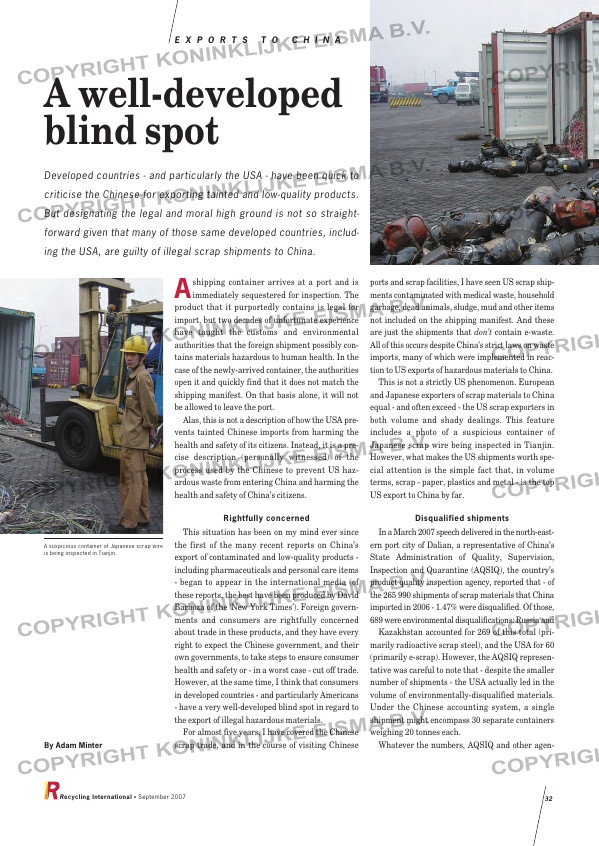Page 32 from: September 2007

A shipping container arrives at a port and isimmediately sequestered for inspection. The
product that it purportedly contains is legal for
import, but two decades of unfortunate experience
have taught the customs and environmental
authorities that the foreign shipment possibly con-
tains materials hazardous to human health. In the
case of the newly-arrived container, the authorities
open it and quickly find that it does not match the
shipping manifest. On that basis alone, it will not
be allowed to leave the port.
Alas, this is not a description of how the USA pre-
vents tainted Chinese imports from harming the
health and safety of its citizens. Instead, it is a pre-
cise description (personally witnessed) of the
process used by the Chinese to prevent US haz-
ardous waste from entering China and harming the
health and safety of China’s citizens.
Rightfully concerned
This situation has been on my mind ever since
the first of the many recent reports on China’s
export of contaminated and low-quality products –
including pharmaceuticals and personal care items
– began to appear in the international media (of
these reports, the best have been produced by David
Barboza of the ‘New York Times’). Foreign govern-
ments and consumers are rightfully concerned
about trade in these products, and they have every
right to expect the Chinese government, and their
own governments, to take steps to ensure consumer
health and safety or – in a worst case – cut off trade.
However, at the same time, I think that consumers
in developed countries – and particularly Americans
– have a very well-developed blind spot in regard to
the export of illegal hazardous materials.
For almost five years, I have covered the Chinese
scrap trade, and in the course of visiting Chinese
ports and scrap facilities, I have seen US scrap ship-
ments contaminated with medical waste, household
garbage, dead animals, sludge, mud and other items
not included on the shipping manifest. And these
are just the shipments that don’t contain e-waste.
All of this occurs despite China’s strict laws on waste
imports, many of which were implemented in reac-
tion to US exports of hazardous materials to China.
This is not a strictly US phenomenon. European
and Japanese exporters of scrap materials to China
equal – and often exceed – the US scrap exporters in
both volume and shady dealings. This feature
includes a photo of a suspicious container of
Japanese scrap wire being inspected in Tianjin.
However, what makes the US shipments worth spe-
cial attention is the simple fact that, in volume
terms, scrap – paper, plastics and metal – is the top
US export to China by far.
Disqualified shipments
In a March 2007 speech delivered in the north-east-
ern port city of Dalian, a representative of China’s
State Administration of Quality, Supervision,
Inspection and Quarantine (AQSIQ), the country’s
product quality inspection agency, reported that – of
the 265 990 shipments of scrap materials that China
imported in 2006 – 1.47% were disqualified. Of those,
689 were environmental disqualifications: Russia and
Kazakhstan accounted for 269 of this total (pri-
marily radioactive scrap steel), and the USA for 60
(primarily e-scrap). However, the AQSIQ represen-
tative was careful to note that – despite the smaller
number of shipments – the USA actually led in the
volume of environmentally-disqualified materials.
Under the Chinese accounting system, a single
shipment might encompass 30 separate containers
weighing 20 tonnes each.
Whatever the numbers, AQSIQ and other agen-
E X P O R T S T O C H I N A
Recycling International • September 2007 32
A well-developed
blind spot
Developed countries – and particularly the USA – have been quick to
criticise the Chinese for exporting tainted and low-quality products.
But designating the legal and moral high ground is not so straight-
forward given that many of those same developed countries, includ-
ing the USA, are guilty of illegal scrap shipments to China.
By Adam Minter
A suspicious container of Japanese scrap wire
is being inspected in Tianjin.
RI_004 Exports China:Opmaak 1 05-09-2007 11:14 Pagina 32



